To the moon Researchers reflect on the 50th anniversary of the Apollo 11 moon landing
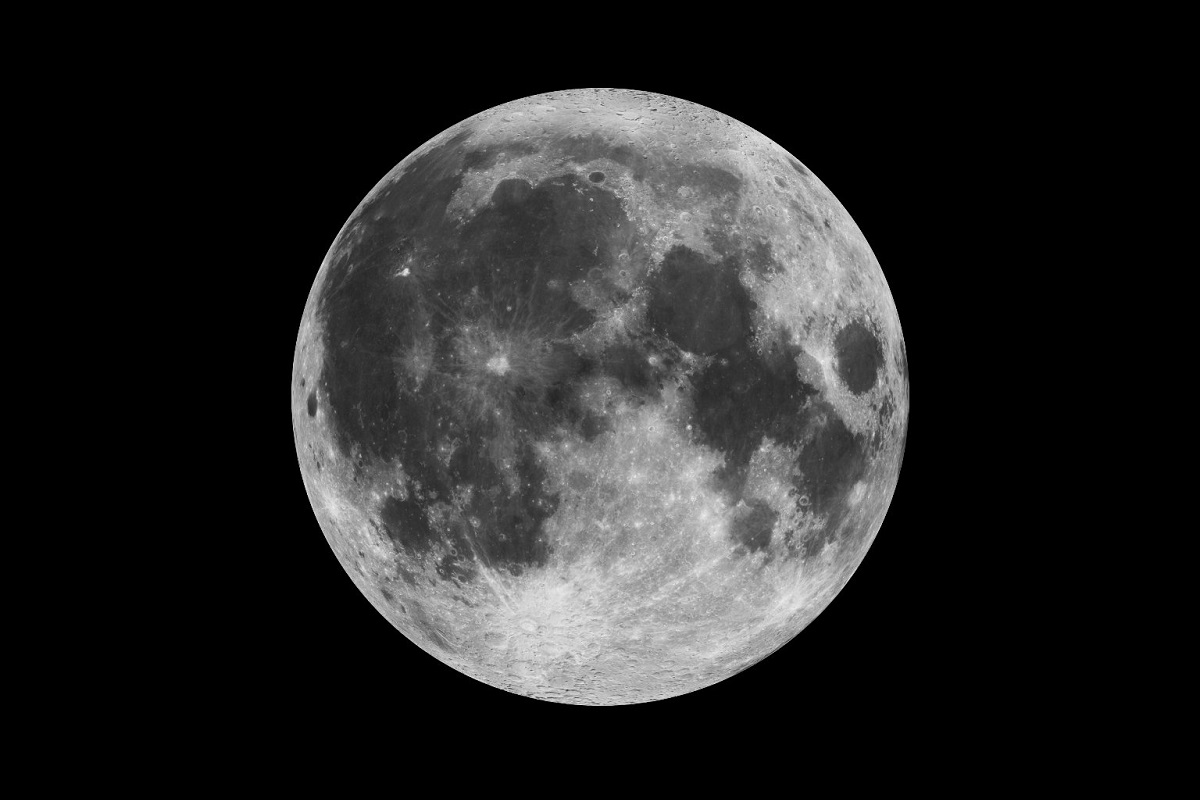
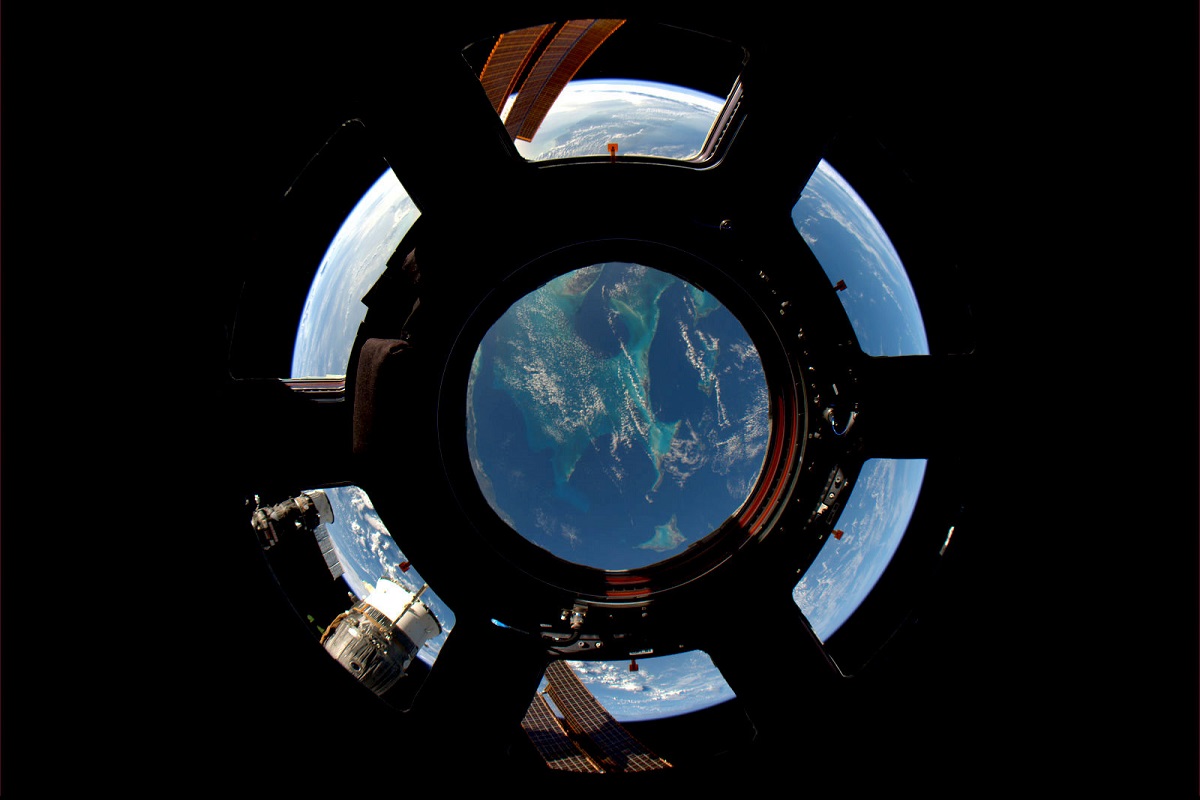
The "blue marble" of Earth as seen from the International Space Station in 2010. Image by Soichi Noguchi.
Mankind first walked on the moon 50 years ago on July 20, 1969. To commemorate the event, we asked 12 researchers to comment on their recollections of the Apollo 11 moon landing and their hopes for the next 50 years of space science achievements. Read on for their personal responses.
Astronaut Soichi Noguchi
Astronaut with the Japan Aerospace Exploration Agency (JAXA) and Research Center for Advanced Science and Technology project research associate
About: Noguchi has spent a total of 177 days, 3 hours, 5 minutes in space. He worked on board the International Space Station (ISS) for two weeks in 2005 and for almost six months between 2009 and 2010. Noguichi is scheduled to return to the ISS as part of Expedition 62/63 in late 2019. See photos from his time in space and preparations for the upcoming mission on his Twitter account, @Astro_Soichi.
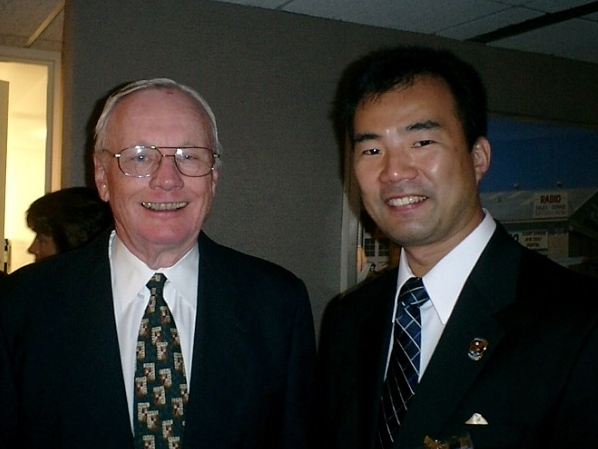
Neil Armstrong (left) and Soichi Noguchi (right) at NASA Headquarters attending the celebration of the 35th anniversary of the Apollo 11 moon landing in 2004. Image courtesy of Soichi Noguchi.
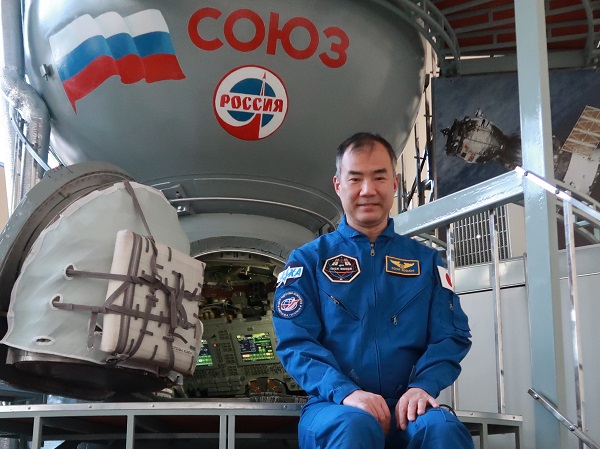
Noguchi at the Gagarin Cosmonaut Training Center in Russia in 2019. Image courtesy of Soichi Noguchi.
I learned about the moon landing in a history book at elementary school. In the 50 years since the Apollo 11 moon landing, we accomplished great achievements in space utilization, but I am happy to know that we are now heading back to the moon as an international project.
I watched the first space shuttle launch on TV when I was a high school student. Since then, space travel was my dream, and I chose to study aerospace engineering at the University of Tokyo.
I am currently a project research associate in the Tojisha-Kenkyu (Research of One’s Own Experience) Laboratory at the Research Center for Advanced Science and Technology. The purpose of my research is to investigate how spaceflight affects astronauts’ spatial orientation, cognitive systems and interpersonal relationships.
Space science has produced benefits that improve the quality of our life on Earth. The challenges of space exploration sparked new scientific and technological knowledge, which gives us new perspectives, leading to better understanding of our universe.
The next 50 years of space activity will definitely generate more benefits for people around the world. I am confident that continued investments in space exploration will have positive impacts for future generations.
Astronaut Naoko Yamazaki
Formerly an astronaut with JAXA and currently a Ph.D. student with the Graduate School of Engineering, Department of Aeronautics & Astronautics
About: Yamazaki served as an astronaut with JAXA from 1999 to 2011, including two weeks aboard the ISS as loadmaster of the STS-131 mission in April 2010. She operated the robotic arms of the ISS and space shuttle and led the transfer six tons of supplies and equipment to the space station. Currently, Yamazaki is a doctoral student in the Intelligent Space Systems Lab, while also serving as a member of the Space Policy Committee of the Cabinet Office of Japan. She is on Twitter as @Astro_Naoko.
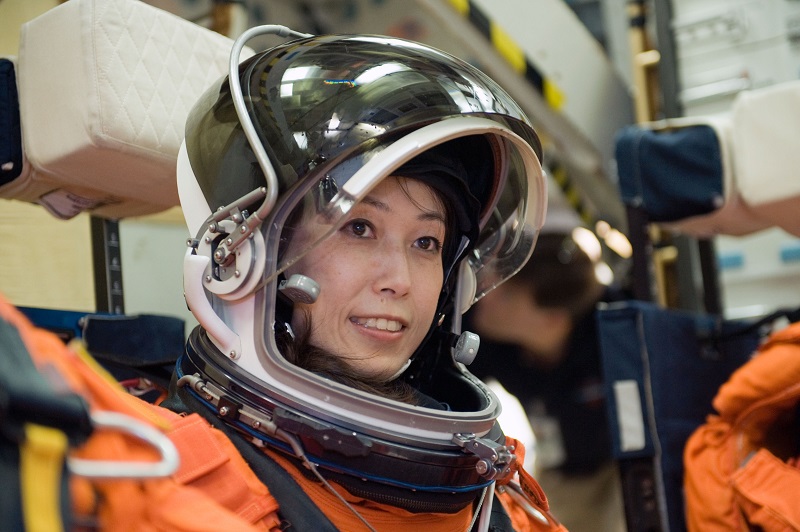
Yamazaki at the Johnson Space Center in 2009.Image by NASA.
I was born a year after the Apollo 11 moon landing. I was excited when I learned about the challenges of Apollo missions in books and museums. I consider human space exploration to be a common goal of humanity to explore the unknown and to answer profound questions about ourselves.
Cosmos, a book and TV series written by Dr. Carl Sagan (a popular American astronomer), and science fiction movies like “Star Wars” made me interested in space and inspired me to become an aerospace engineer and astronaut.
My current research studies a new space transportation system with fuel stations and reusable orbital transfer vehicles. This concept will lower the launch cost and give more flexibility for deep space explorations.
Knowing about space expands our boundaries of science and also expands our understanding about ourselves, human beings, and our home planet Earth.
I hope space science, collaborating with various other science, will enable us to travel freely to space, which would enhance our appreciation of the Earth and happiness of human beings.
Professor Shinichi Nakasuka
Graduate School of Engineering, Department of Aeronautics & Astronautics
About: Nakasuka was previously a visiting researcher at the University of Maryland (1996-1997) and Stanford University (1999). In 2003, he developed and launched the world’s first 1-kilogram (2.2-pound) CubeSat, a satellite made out of an aluminum drink can. He received a Japanese Prime Minister Award for his role in the Hodoyoshi (Reasonably Reliable) Project, which established the infrastructure to develop and use microsatellites. Currently, Nakasuka is a member of the Space Policy Committee of the Cabinet Office of Japan and leads the Intelligent Space Systems Lab, applying artificial intelligence to space systems.
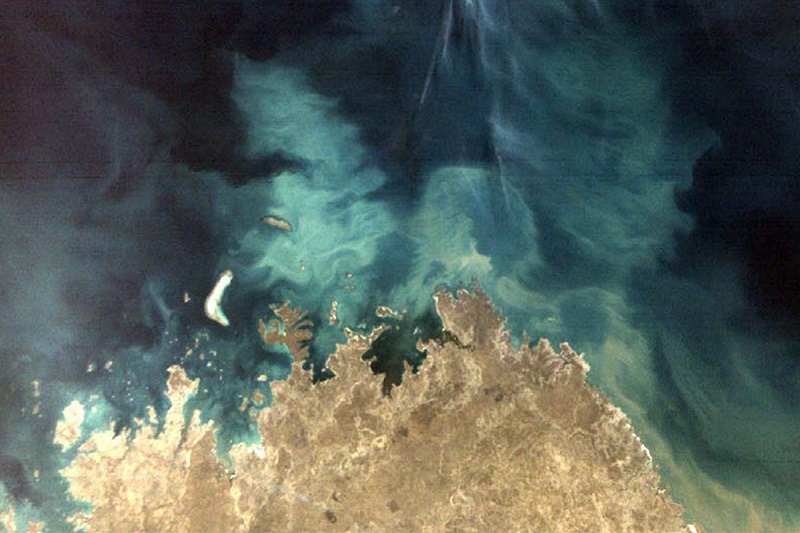
The satellite Hodoyoshi-3 took this photo of northern Australia. Image by Hodoyoshi-3&4 Project, CC-BY-SA.
I remember that I watched the scene of the Apollo 11 landing with my father in the late night. That was so impressive. But I remember more about the return trip of Apollo 11. When it re-entered Earth’s atmosphere, the angle with respect to local horizon should be something like between 5 to 6 degrees, which seemed to be like a knife-edge. I was wondering, if the insertion was unsuccessful, what will happen to the astronauts? And because of this feeling, I could not sleep well until Apollo safely returned to Earth. My first feeling about space was, therefore, “it is a very dangerous area.”
I liked aircraft since I was 5 years old. But when I saw the Apollo 11 landing on the moon at the age of eight, I was so impressed by the space technologies, which inspired me to be a researcher. The next year (1970), I went to the Osaka international exhibition where I saw the moon stone, which further gave me motivation towards research in the space field.
In my laboratory, I am developing very small satellites (1 kg to 100 kg) so that everyone can use space for their own interest, including Earth observation, space science and exploration, entertainment or education.
Human beings have a natural tendency to explore the world outside the area where they live, which triggers the evolution of human beings. Of course, Earth observation or other practical missions of satellites can improve everyday life on Earth, but beyond that, the largest effect of such space activities is to stimulate human beings to get to a higher level.
My hopes for the next 50 years are that, first, lunar exploration will advance and human permanent settlement on the moon will happen within 20 years. Then human exploration to planets will occur within 30 years. As for the future of space science, many advancements in various areas will happen continually, the results of which I cannot imagine now.
Professor Hideaki Miyamoto
Graduate School of Engineering, Department of Systems Innovation
About: Miyamoto studies the surfaces of solid objects around our solar system, including the moon, Mars and asteroids. He has been part of the JAXA projects to study the surface of the moon (SELENE lunar mission) and asteroids (Hayabusa and Hayabusa2). He also oversees the TeNQ Space Museum at Tokyo Dome City.
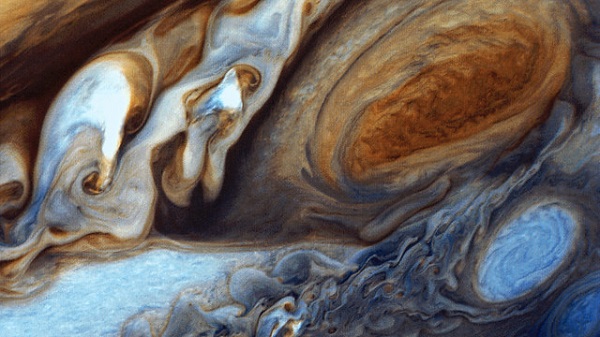
The great red spot on Jupiter, as seen by Voyager 1 in 1979. Image by NASA.
I was born after the Apollo 11 landing, so I grew up thinking and am still believing now that going out in space is a natural and necessary step for human beings.
When I was a schoolboy, the Voyager spacecraft took amazing photos of Jupiter and Saturn, which was a great shock to me. I was surprised at the existence of different worlds and by the capability of human beings to reach them.
We’re living on Earth, so we need to fully understand Earth. Space science is a fundamental science to figure out how Earth is unique, special and sized.
I study the geology and surface environment of planets, satellites and asteroids to figure out how Earth is similar to or different from these bodies. I’m also interested in space resources, too.
For the next 50 years, I believe space science should be greatly advanced and appropriately shared with everybody on Earth.
Matthew Richardson
Graduate School of Engineering, Department of Aeronautics and Astronautics
About: Richardson, originally from Australia, is currently a Ph.D. student in the Department of Aeronautics and Astronautics. His research is focused on how to extend the useful life of rocket engines. He participated in the 2019 UTokyo 3MT competition.
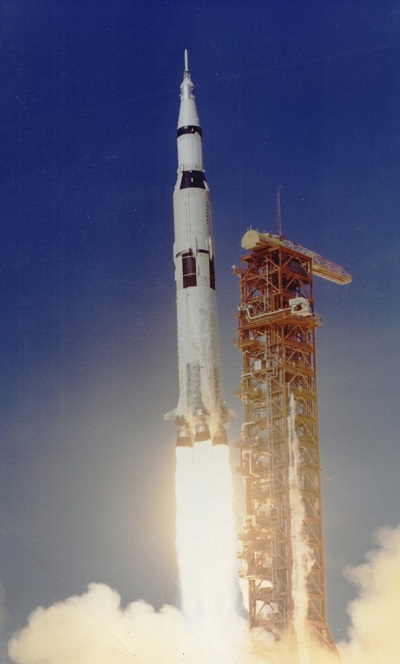
The Saturn V rocket launched Apollo 11 into space. Image by NASA.
I grew up in the 1990s watching movies like Apollo 13, while space shuttle missions were a regular occurrence and the International Space Station was being built. Space travel seemed like the ultimate challenge: near-impossible problems to solve, but unbelievable rewards. It felt like the greatest endeavor in human history and the Apollo missions were proof of what could be achieved.
I worked as an engineer in the private sector before starting my Ph.D. at the University of Tokyo. I always wanted to work at the frontiers of knowledge and innovation.
Most rockets in the world today are used just once then thrown away. My research is helping to figure out how we can recycle them instead.
There are many ways space science and technology benefit us on a daily basis, which we barely notice. Earth observation has increased our understanding of planet Earth by orders of magnitude, and this data is becoming more and more accessible. Meteorological satellites have improved weather predictions dramatically. Satellite communications are the backbone of our global networks. Positioning, timing and navigation technologies (PTN) like GPS have a wide range of uses, from helping you navigate in your car to ensuring that the clocks in ATMs run accurately. Space technology enables our modern world to exist; the more we develop it, the more benefits we can realize in the future.
In recent years, our knowledge of exoplanets (planets orbiting stars other than the sun) has increased at an incredible pace. In less than a generation, we’ve gone from not even being sure exoplanets exist to identifying thousands of them, and being able to measure their size, orbit and even atmospheres. If we continue on this trajectory, we may find concrete evidence of habitable planets or even life and biospheres light-years away. At the same time, we’re increasing our ability to explore our own solar system, with larger, smarter and more capable probes heading out to our closest neighbors to make discoveries.
Thinking about the future of space exploration, I’m excited to see missions to outer planet moons like Europa and Titan. The unique environments on these worlds are an irresistible source of curiosity, and profound discoveries could await us there.
Professor Masahiro Hoshino
Graduate School of Science, Director of the UTokyo Organization for Planetary and Space Science (UTOPS)
About: Hoshino studies the physics of plasma dynamics throughout the universe and is the director of UTOPS, a UTokyo research organization dedicated to fundamental research about our solar system and the universe. In 2016, he was chosen as a fellow of the American Geophysical Union “for pioneering work on particle acceleration in collisionless magnetic reconnection and shock waves in planetary and astrophysical plasmas.”
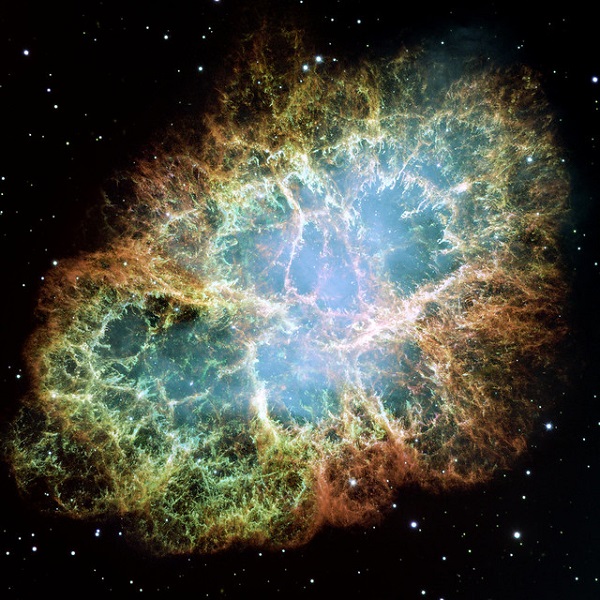
The Crab Nebula was formed by a supernova. Image by NASA, ESA, J. Hester and A. Loll (Arizona State University), CC-BY.
The deep mystery in the universe inspired me to become a researcher. We can see the universe by using a telescope, but we cannot directly touch it with our hands.
I was glued to the TV broadcasts of astronaut Neil Armstrong and Apollo 11. I listened many times to the recordings of the famous phrase, “That's one small step for man, one giant leap for mankind,” and all the communication between Apollo 11 and the NASA operation center. One year after Apollo 11, I saw the lunar rock at the Japan World Expo in Osaka. I realized that we could reach the universe.
My current research focuses on the origin and evolution of hot gas (plasma) and energetic particles (cosmic rays) that appear to occupy much of the volume of the universe. Specifically, I investigate energetic phenomena such as supernovae, pulsar and astrophysical jets in the universe, as well as solar flares and auroras in the solar system.
The direct influence of my fundamental research on our daily life may be limited. If anything, it would be a small, but first step towards a big discovery that is beneficial to our future life. Space science can give an ultimate impression, and can satisfy our sense of curiosity.
For the next 50 years, I look forward to further development of space science and understanding the fundamental principle of our universe. Specifically, in my research field, the physics of plasma heating and particle acceleration in collisionless shock waves and magnetic reconnection that are key agents of energetic phenomena will be solved.
Mayuko Mori
Graduate School of Science, Department of Astronomy
About: Mori is currently a master’s degree student in the laboratory of Professor Motohide Tamura, where she studies Earth-sized planets orbiting other stars in our galaxy. Some of her research has taken her to the Teide Observatory in Spain. Mori is also a co-organizer of the monthly science communication event, Space Cafe Tokyo.
I don’t remember how I learned about Apollo 11 for the first time, but maybe it was a TV show or something. As a child, I took it as just one normal event in human history. As I got older, I realized what a big challenge it was for human beings. I saw a real-size model of the Apollo command and service module at the joint NASA-JAXA Space Expo 2014 in Chiba, and I was able to imagine their lonely journey to the moon.
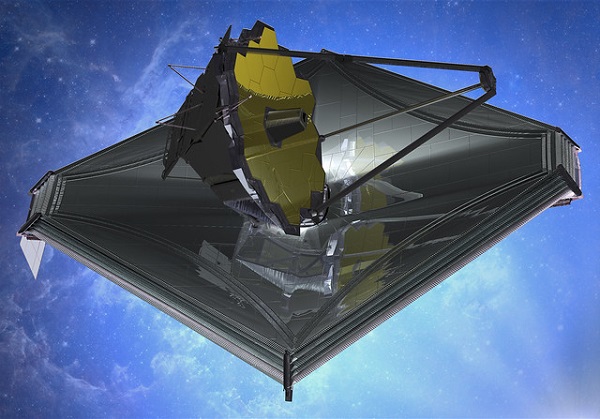
Artist rendering of the James Webb Space Telescope, which is still under construction. Mori and other astronomers have high hopes for the next generation of telescopes. Image by Northrop Grumman CC-BY-NC-SA.
The fundamental question “Where are we from?” is my motivation for research. Since I was a high school student, I really liked to think about physical phenomena around us, such as rainbows, bubbles and, above all, our universe. I decided to study astronomy because I think it’s really fun to explore many unsolved mysteries about the origin of life in the universe.
Now, I am doing observational research on extrasolar planets (planets outside the solar system) using ground-based telescopes. I am especially interested in the atmosphere of a few Earth-sized planets, to know the formation and evolution process of those planets and their habitability.
I think there is no “immediate benefit” of space research for our ordinary life, except for the great evolution of technology brought by space science investigation. But what is more important is that space science broadens our perspective.
Imagine what would happen if we knew there is another life in the universe. Or, if we knew we are alone in the universe? I think it would completely change our view of life and this world.
As for the future of space research, we have a lot of exciting plans for the new-generation telescopes to be launched in the next 10 years, such as the James Webb Space Telescope and Thirty Meter Telescope. With these telescopes, we will be able to observe the main components of the atmosphere of some kind of Earth-sized extrasolar planets. In 50 years, we may be able to catch evidence of the existence of living organisms on another planet. Not only exoplanet science, but the whole field of space science will be able to answer some questions which we have now about our universe, but I guess there will still remain a lot of mysteries.
Professor Motohide Tamura
Graduate School of Science, Department of Astronomy
About: Tamura is an expert in the search for Earth-sized planets in other solar systems. He led a multiyear program to observe exoplanets using the Subaru telescope. He was previously a postdoctoral fellow at the NASA Jet Propulsion Lab from 1990 to 1992.
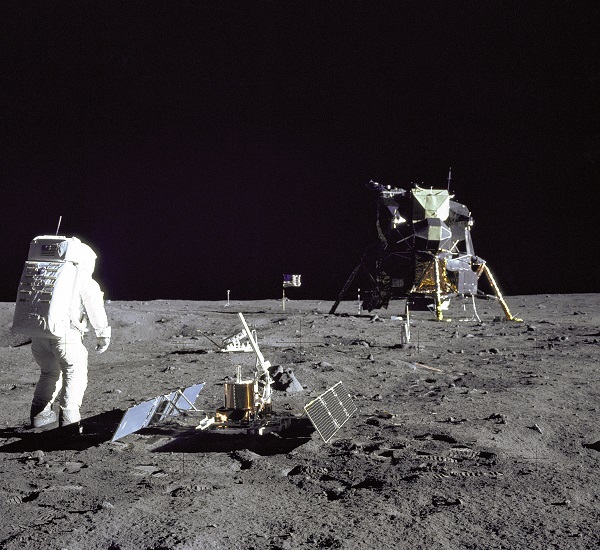
Buzz Aldrin looks at Tranquility base on the moon in 1969. Image by NASA.
I was only 10 years old at that time, watching the Apollo 11 landing on TV. It was the most exciting scene I have seen on TV in my entire life.
I was hoping to become a scientist when I was a child. I liked natural phenomena including starry night sky.
My research is to find and characterize planets outside our solar system with telescopes and specialized instruments that I have developed with collaborators, eventually hoping to find a signature of life on those planets.
With the discovery and subsequent enormous development of exoplanet science, we now know Earth-like planets are abundant in the universe, but we still do not know if life is universal or not. This always reminds me how precious any life on the Earth is.
Fifty years ago, most of us were dreaming that humans will soon make a moon base and land on the nearby planet Mars, but even returning to the moon did not happen again after the Apollo missions. On the other hand, our knowledge of the universe has greatly expanded in the last 50 years via unmanned missions and various telescopes. It is true that such manned space exploration like Apollo can attract many people and motivate the young generation for space, however. Considering the huge cost of manned missions, a good balance between manned and unmanned missions will be important for the next 50 years of space science.
Professor Kanako Seki
Graduate School of Science, Department of Earth and Planetary Science
About: Seki is an expert in space physics who studies space weather, including the interactions between charged particles and Earth’s magnetic field, which are responsible for phenomena like the colorful aurora in Earth’s upper atmosphere. She was a graduate research assistant at Los Alamos National Laboratory, USA, in 1999. Seki contributed to the NASA MAVEN mission to study the atmosphere of Mars and currently leads one of the teams on ERG, a JAXA co-sponsored project combining data from satellites, ground-based observations and numerical simulations to understand particle acceleration in space storms.
I first learned about Apollo 11 probably when I was around 3 years old. I do not remember it very well, but my mother told me that I started to draw many pictures of the moon and rocket together … I guess the photo of the human on the moon was very impressive and inspirational for a small child.
I remember that many spectacular images from the Voyager mission inspired my interests in space and the universe a lot in my elementary and middle school days, and gave me the impression that space is a new frontier for our generation. However, I decided to be a researcher much later.
In my research group, we are investigating what conditions make terrestrial planets habitable through comparative studies of Mars, Earth, Venus and Mercury based on satellite observations and numerical simulations. We also study mechanisms to cause variations of the space environment around the planets.
Understanding the mechanisms of dynamic variations in the space environment helps us to better operate our social infrastructures in space, such as GPS satellites. Knowing the recipe for a habitable planet will give us clues to maintain our habitable environment on Earth and a scientific basis to identify habitable exoplanets, which will widen our worldview.
I hope the next 50 years will be the age of discovery and exploration to many objects in our solar system, and wish for new space-born observations to change our understanding of the universe.
Professor Seiji Sugita
Graduate School of Science, Department of Earth and Planetary Environmental Science
About: Sugita earned his Ph.D. from Brown University, USA, and completed a fellowship at NASA’s Ames Research Center in 2000. His research group in the Department of Earth and Planetary Science uses super high-speed collisions and high-energy lasers to study the formation and evolution of planets, including Earth. Sugita leads the scientific team in charge of the optical navigation cameras on Hayabusa2, the JAXA spacecraft sent to the asteroid Ryugu. The Hayabusa2 research team recently celebrated the second successful touchdown on asteroid Ryugu on July 11, 2019.
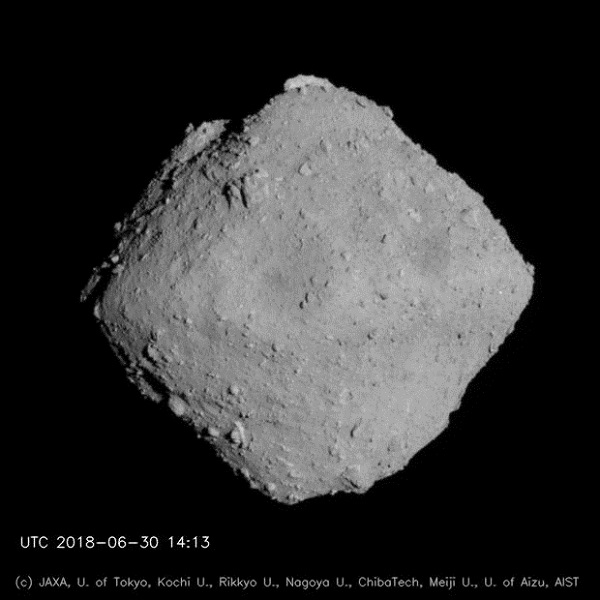
The asteroid Ryugu as seen by the spacecraft Hayabusa2. Image by JAXA/UTokyo/Kochi U/Rikkyo U/Nagoya U/Chiba Inst Tech/Meiji U/U Aizu/AIST.
I was too young (only 1 year old) to understand Apollo 11 at that time, but my childhood was full of excitement from the Apollo achievement. I remember the Apollo 11 landing as the moment when the door to real human space exploration opened. Apollo was followed by a series of solar system exploration, such as Mars by Viking, Venus by Venera, Jupiter and Saturn by Voyager.
I had many inspirations in my childhood, but the biggest one was a weekend science club created by local teachers in my hometown. The club was nothing to do with grades at school and was about having fun with science.
I am in charge of science observations using the camera of Hayabusa2, a JAXA mission for getting samples from carbon-rich asteroid, Ryugu.
Space science, particularly planetary science, gives us perspectives different from daily life on Earth. A planetary perspective allows us to realize that Earth is just a small isolated body in a vast, dead and vacant space. Just a simple picture of the Earth has such an impact. More quantitative science observations and analyses of Earth give us more fundamental knowledge and insight about how we should manage our own planet. We don't have a replacement. This is very useful for our lives and society on Earth.
Fifty years ago, we began to learn the general idea about how planets were formed. That has led to our great understanding on the variety of different planets in the solar system. Among the variety is the presence of surface liquid water on Mars and many underground oceans in icy moons. They could host life forms. Furthermore, many Earth-like planets outside our solar system are being found now. The coming 50 years of space science is the quest for life in the universe.
Professor Takashi Mikouchi
University Museum
About: Mikouchi is an expert in meteorites from Mars and the moon that have landed on Earth. He was a postdoctoral fellow at the NASA Johnson Space Center for one year (April 1999 to March 2000) and spent four months in Antarctica (December 2012 to February 2013) as part of the 54th Japanese Antarctic Research Expedition.
I first learned about Apollo 11 closely when I visited NASA when I was a 9-year-old kid. Because I could touch the stone from the moon, I felt great! It was amazing that astronauts brought it back to the Earth, and so it traveled 380,000 kilometers!
I was simply interested in natural science when I was a kid. Especially, space science was the biggest interest. I simply pursued the interest to become a researcher.
In my research, I am studying rocks from space such as meteorites and lunar rocks. They could tell us how our solar system was born and how the Earth became a blue planet.
It is a bit difficult to say that space science, especially my research, brings about immediate benefit to our life. However, space science can broaden our knowledge and we can recognize ourselves and our planet much deeper.
In the coming 50 years, I hope that we can obtain more samples from other solar system bodies, including Mars, to have a better understanding of the birth and evolution of our solar system.
Looking for more?
The University of Tokyo has a long history of space science research. On the Hongo Campus, you can see two of Japan’s first pieces of space equipment: the Pencil rocket and Ohsumi satellite.
If you’d like to learn more about the University of Tokyo’s involvement in space research, please visit the website of the UTokyo Organization for Planetary and Space Science.

The moon as seen from Earth. Image by NASA/GSFC.






